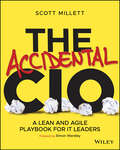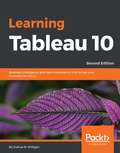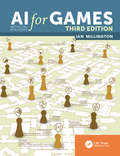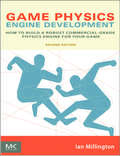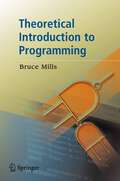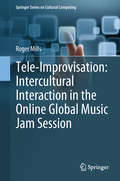- Table View
- List View
The Accidental CIO: A Lean and Agile Playbook for IT Leaders
by Scott MillettAn indispensable guide showing IT leaders the way to balance the needs of innovation and exploration with exploitation and operational reliability Many books on modern IT leadership focus solely on supporting innovation and disruption. In practice these must be balanced with the need to support waste reduction in existing processes and capabilities while keeping the foundation operational, secure, compliant with regulations, and cost effective. In The Accidental CIO, veteran software developer-turned-executive Scott Millett delivers an essential playbook to becoming an impactful, strategic leader at any stage of your IT leadership journey from your earliest aspirations to long time incumbents in director and C-suite roles. You’ll find a wealth of hands-on advice for tackling the many challenges and paradoxes that face technology leaders, from creating an aligned IT strategy, defining a target architecture, designing a balanced operating model, and leading teams and executing strategy. After the foreword from Simon Wardley, The Accidental CIO will help you: Understand problem contexts you will face using the Cynefin decision making framework, and how the philosophies of agile, lean and design thinking can help manage them. Design an adaptive and strategically aligned operating model by applying the appropriate ways of working and governance approaches depending on each unique problem context. Organize a department using a blend of holacratic and hierarchical principles, and leveraging modern approaches such as Team Topology and Socio-technical patterns. Develop and deploy an effective and aligned IT Strategy using Wardley mapping based on a deep knowledge of your business architecture. With this knowledge you’ll be ready to create an empowered IT organization focused on solving customer problems and generating enterprise value. You’ll understand the science behind what motivates teams and changes behavior. And you’ll show your skills as a business leader thinking beyond IT outputs to impactful business outcomes.
The Accidental CIO: A Lean and Agile Playbook for IT Leaders
by Scott MillettAn indispensable guide showing IT leaders the way to balance the needs of innovation and exploration with exploitation and operational reliability Many books on modern IT leadership focus solely on supporting innovation and disruption. In practice these must be balanced with the need to support waste reduction in existing processes and capabilities while keeping the foundation operational, secure, compliant with regulations, and cost effective. In The Accidental CIO, veteran software developer-turned-executive Scott Millett delivers an essential playbook to becoming an impactful, strategic leader at any stage of your IT leadership journey from your earliest aspirations to long time incumbents in director and C-suite roles. You’ll find a wealth of hands-on advice for tackling the many challenges and paradoxes that face technology leaders, from creating an aligned IT strategy, defining a target architecture, designing a balanced operating model, and leading teams and executing strategy. After the foreword from Simon Wardley, The Accidental CIO will help you: Understand problem contexts you will face using the Cynefin decision making framework, and how the philosophies of agile, lean and design thinking can help manage them. Design an adaptive and strategically aligned operating model by applying the appropriate ways of working and governance approaches depending on each unique problem context. Organize a department using a blend of holacratic and hierarchical principles, and leveraging modern approaches such as Team Topology and Socio-technical patterns. Develop and deploy an effective and aligned IT Strategy using Wardley mapping based on a deep knowledge of your business architecture. With this knowledge you’ll be ready to create an empowered IT organization focused on solving customer problems and generating enterprise value. You’ll understand the science behind what motivates teams and changes behavior. And you’ll show your skills as a business leader thinking beyond IT outputs to impactful business outcomes.
NHibernate with ASP.NET Problem Design Solution (Wrox Blox #89)
by Scott MillettThis Wrox Blox demonstrates how to start using NHibernate in line business applications using ASP.NET and VB.NET. Using NHibernate will speed up your application development by removing the need to build your own Data Access Layer (DAL). In addition, you can focus solely on the business problem instead of the infrastructure concerns. Using a simple demo application as an example, this Wrox Blox shows how easy it is to get started with NHibernate and build your DAL in minutes instead of hours. Readers will also see how the POCO pattern enables you to keep your DAL as unobtrusive as possible as well as being interchangeable for future DAL implementations. You will also see how NHibernate has many enterprise patterns built into it, like the Unit of Work pattern and the Identity Map. Table of Contents What Is an Object Relational Mapper? 2 Why NHibernate? 2 Part 1: Getting Started with NHibernate 2 A Quick Demo 2 Part 2: The NHibernate Framework 13 Architecture and Core Concepts 13 Mapping Your Entities: Impedance Mismatch 16 Persisting Business Objects 18 Part 3: Using NHibernate 19 Introducing the Project and Laying out the Solution Framework 19 Designing the Domain Model 23 NHibernate Repository Project: Base Class 39 Managing Products 48 Managing Customers 58 NHibernate Repository Project: Refactoring and Session Management 69 Managing Orders 74 The Database — A Question of Storage 94 Presentation with the Model–View–Presenter Pattern 96 User Interface: ASP.NET 103 Part 4: Other NHibernate Bits and Pieces 113 Other Querying Methods 113 Mapping Inheritance 115 What Kind of SQL Is Being Produced? 118 Wrap Up 119 Scott Millett 120
Professional ASP.NET Design Patterns
by Scott MillettDesign patterns are time-tested solutions to recurring problems, letting the designer build programs on solutions that have already proved effective Provides developers with more than a dozen ASP.NET examples showing standard design patterns and how using them helpsbuild a richer understanding of ASP.NET architecture, as well as better ASP.NET applications Builds a solid understanding of ASP.NET architecture that can be used over and over again in many projects Covers ASP.NET code to implement many standard patterns including Model-View-Controller (MVC), ETL, Master-Master Snapshot, Master-Slave-Snapshot, Façade, Singleton, Factory, Single Access Point, Roles, Limited View, observer, page controller, common communication patterns, and more
Professional ASP.NET Design Patterns
by Scott MillettProfessional ASP.NET Design Patterns is all about showing you how to use the power of design patterns and core design principles in real ASP.NET applications. The goal of this book is to educate developers on the fundamentals of object oriented programming, design patterns, principles, and methodologies that can help you become a better programmer. Design patterns and principles enable loosely coupled and highly cohesive code, which will improve your code’s readability, flexibility, and maintenance. Each chapter addresses a layer in an enterprise ASP.NET application and shows how proven patterns, principles, and best practices can be leveraged to solve problems and improve the design of your code. In addition, a professional-level, end-to-end case study is used to show how to use best practice design patterns and principles in a real website. Professional ASP.NET Design Patterns is for ASP.NET developers who are comfortable with the .NET framework but are looking to improve how they code and understand why design patterns, design principles, and best practices will make their code more maintainable and adaptable. Readers who have had experience with design patterns before may wish to skip Part 1 of the book, which acts as an introduction to the Gang of Four design patterns and common design principles, including the S.O.L.I.D. principles and Martin Fowler’s enterprise patterns. All code samples are written in C# but the concepts can be applied very easily to VB.NET. This book covers well-known patterns and best practices for developing enterprise-level ASP.NET applications. The patterns used can be applied to any version of ASP.NET from 1.0 to 4.0. The patterns themselves are language agnostic and can be applied to any object oriented programming language. Professional ASP.NET Design Patterns can be used both as a step-by-step guide and as a continuous source of reference to dip into at your leisure. The book is broken into three distinct sections. Part 1 is an introduction to patterns and design principles. Part 2 examines how patterns and principles can be used in the various layers of an ASP.NET application. Part 3 represents an end-to-end case study showcasing many of the patterns covered in the book. You may find it useful to work through the chapters before reading the case study, or you may find it easier to see the patterns in action by reading the case study section first and referring back to Part 2 for a more detailed view on the patterns and principles used. Within those parts the coverage includes: The origins of the Gang of Four design patterns, their relevance in today’s world, and their decoupling from specific programming languages. An overview of some common design principles and the S.O.L.I.D. design principles follows, and the chapter ends with a description of Fowler’s enterprise patterns. Layering Your Application and Separating Your Concerns A description of the Transaction Script pattern followed by the Active Record, with an exercise to demonstrate the pattern using the Castle Windsor project. The Domain Model pattern demonstrated in an exercise with NHibernate and a review of the domain-driven design (DDD) methodology Patterns and principles that can be used construct your objects and how to make sure that you are building your application for scalability and maintainability: Factory, Decorator, Template, State, Strategy, Composite, Specification and Layer Supertype. Design principles that can improve your code’s maintainability and flexibility; these include Dependency Injection, Interface Segregation, and Liskov Substitution Principle Service Oriented Architecture, the Facade design pattern, messaging patterns such as Document Message, Request-Response, Reservatio
Pro Agile .NET Development with SCRUM
by Scott Millett Jerrel Blankenship Matthew BussaPro Agile .NET Development with SCRUM guides you through a real-world ASP.NET project and shows how agile methodology is put into practice. There is plenty of literature on the theory behind agile methodologies, but no book on the market takes the concepts of agile practices and applies these in a practical manner to an end-to-end ASP.NET project, especially the estimating, requirements and management aspects of a project. Pro Agile .NET Development with SCRUM takes you through the initial stages of a project—gathering requirements and setting up an environment—through to the development and deployment stages using an agile iterative approach: namely, Scrum. In the book, you'll focus on delivering an enterprise-level ASP.NET project. Each chapter is in iterations or sprints, putting into practice the features of agile—user stories, test-driven development (TDD), behavior-driven development (BDD), continuous integration, user acceptance testing, extreme programming, Scrum, design patterns and principles, inside-out development, lean developent, KanBan boards, and more. An appendix features code katas designed for the reader to get up-to-speed with some of the features of extreme programming, while also showcasing popular open-source frameworks to assist in automated testing and mocking. In addition, popular open-source architectural foundation projects such as S#arp and NCommons are demonstrated to allow you to base future projects on these frameworks, which already have many best-practice design patterns and principles built in.
Patterns, Principles, and Practices of Domain-Driven Design
by Scott Millett Nick TuneMethods for managing complex software construction following the practices, principles and patterns of Domain-Driven Design with code examples in C# This book presents the philosophy of Domain-Driven Design (DDD) in a down-to-earth and practical manner for experienced developers building applications for complex domains. A focus is placed on the principles and practices of decomposing a complex problem space as well as the implementation patterns and best practices for shaping a maintainable solution space. You will learn how to build effective domain models through the use of tactical patterns and how to retain their integrity by applying the strategic patterns of DDD. Full end-to-end coding examples demonstrate techniques for integrating a decomposed and distributed solution space while coding best practices and patterns advise you on how to architect applications for maintenance and scale. Offers a thorough introduction to the philosophy of DDD for professional developers Includes masses of code and examples of concept in action that other books have only covered theoretically Covers the patterns of CQRS, Messaging, REST, Event Sourcing and Event-Driven Architectures Also ideal for Java developers who want to better understand the implementation of DDD
Patterns, Principles, and Practices of Domain-Driven Design
by Scott Millett Nick TuneMethods for managing complex software construction following the practices, principles and patterns of Domain-Driven Design with code examples in C# This book presents the philosophy of Domain-Driven Design (DDD) in a down-to-earth and practical manner for experienced developers building applications for complex domains. A focus is placed on the principles and practices of decomposing a complex problem space as well as the implementation patterns and best practices for shaping a maintainable solution space. You will learn how to build effective domain models through the use of tactical patterns and how to retain their integrity by applying the strategic patterns of DDD. Full end-to-end coding examples demonstrate techniques for integrating a decomposed and distributed solution space while coding best practices and patterns advise you on how to architect applications for maintenance and scale. Offers a thorough introduction to the philosophy of DDD for professional developers Includes masses of code and examples of concept in action that other books have only covered theoretically Covers the patterns of CQRS, Messaging, REST, Event Sourcing and Event-Driven Architectures Also ideal for Java developers who want to better understand the implementation of DDD
Learning Tableau
by Joshua N. MilliganIf you want to understand your data using data visualization and don't know where to start, then this is the book for you. Whether you are a beginner or have years of experience, this book will help you to quickly acquire the skills and techniques used to discover, analyze, and communicate data visually. Some familiarity with databases and data structures is helpful, but not required.
Learning Tableau 10 - Second Edition
by Joshua N. MilliganLearn how to create effective data visualizations with Tableau and unlock a smarter approach to business analytics. It might just transform your organizationAbout This BookCreate stylish visualizations and dashboards that explain complexity with clarityLearn effective data storytelling to transform how your business uses ideas and makes decisionsExplore all the new features in Tableau 10 and start to redefine what business analytics means to your organizationWho This Book Is ForGot data? Not sure what to make of it? This is the guide for you – whether you've been working with Tableau for years or are just beginning your adventure into business analytics.What You Will LearnFind out how to build effective visualizations and dashboardsPrepare and clean your data so you can be sure Tableau is finding answers to your questions – not raising more problemsDiscover how to create advanced visualizations that explain complexity with clarity and styleDig deeper into your data with clustering and distribution models that allow you to analyze trends and make forecastsLearn how to use data storytelling to aid decision-making and strategyShare dashboards and visualizations to cultivate a culture where data is available and valuedIn DetailTableau has for some time been one of the most popular Business Intelligence and data visualization tools available. Why? Because, quite simply, it's a tool that's responsive to the needs of modern businesses. But it's most effective when you know how to get what you want from it – it might make your business intelligent, but it isn't going to make you intelligent...We'll make sure you're well prepared to take full advantage of Tableau 10's new features. Whether you're an experienced data analyst that wants to explore 2016's new Tableau, or you're a beginner that wants to expand their skillset and bring a more professional and sharper approach to their organization, we've got you covered. Beginning with the fundamentals, such as data preparation, you'll soon learn how to build and customize your own data visualizations and dashboards, essential for high-level visibility and effective data storytelling. You'll also find out how to so trend analysis and forecasting using clustering and distribution models to inform your analytics.But it's not just about you – when it comes to data it's all about availability and access. That's why we'll show you how to share your Tableau visualizations. It's only once insights are shared and communicated that you – and your organization – will start making smarter and informed decisions. And really, that's exactly what this guide is for.Style and approachPractical yet comprehensive, this Tableau guide takes you from the fundamentals of the tool before diving deeper into creating advanced visualizations. Covering the latest features found in Tableau 10, this might be the guide that transforms your organization.
Learning Tableau 2019: Tools For Business Intelligence, Data Prep, And Visual Analytics, 3rd Edition
by Joshua N. MilliganTools for Business Intelligence, Data Prep, and Visual Analytics
Python Projects for Beginners: A Ten-Week Bootcamp Approach to Python Programming
by Connor P. MillikenImmerse yourself in learning Python and introductory data analytics with this book’s project-based approach. Through the structure of a ten-week coding bootcamp course, you’ll learn key concepts and gain hands-on experience through weekly projects.Each chapter in this book is presented as a full week of topics, with Monday through Thursday covering specific concepts, leading up to Friday, when you are challenged to create a project using the skills learned throughout the week. Topics include Python basics and essential intermediate concepts such as list comprehension, generators and iterators, understanding algorithmic complexity, and data analysis with pandas. From beginning to end, this book builds up your abilities through exercises and challenges, culminating in your solid understanding of Python.Challenge yourself with the intensity of a coding bootcamp experience or learn at your own pace. With this hands-on learning approach, you will gain the skills you need to jumpstart a new career in programming or further your current one as a software developer. What You Will Learn Understand beginning and more advanced concepts of the Python languageBe introduced to data analysis using pandas, the Python Data Analysis libraryWalk through the process of interviewing and answering technical questionsCreate real-world applications with the Python languageLearn how to use Anaconda, Jupyter Notebooks, and the Python ShellWho This Book Is ForThose trying to jumpstart a new career into programming, and those already in the software development industry and would like to learn Python programming.
AI for Games (AI for Everything)
by Ian MillingtonWhat is artificial intelligence? How is artificial intelligence used in game development? Game development lives in its own technical world. It has its own idioms, skills, and challenges. That’s one of the reasons games are so much fun to work on. Each game has its own rules, its own aesthetic, and its own trade-offs, and the hardware it will run on keeps changing. AI for Games is designed to help you understand one element of game development: artificial intelligence (AI).
AI for Games (AI for Everything)
by Ian MillingtonWhat is artificial intelligence? How is artificial intelligence used in game development? Game development lives in its own technical world. It has its own idioms, skills, and challenges. That’s one of the reasons games are so much fun to work on. Each game has its own rules, its own aesthetic, and its own trade-offs, and the hardware it will run on keeps changing. AI for Games is designed to help you understand one element of game development: artificial intelligence (AI).
AI for Games, Third Edition
by Ian MillingtonAI is an integral part of every video game. This book helps professionals keep up with the constantly evolving technological advances in the fast growing game industry and equips students with up-to-date information they need to jumpstart their careers. This revised and updated Third Edition includes new techniques, algorithms, data structures and representations needed to create powerful AI in games. Key Features A comprehensive professional tutorial and reference to implement true AI in games Includes new exercises so readers can test their comprehension and understanding of the concepts and practices presented Revised and updated to cover new techniques and advances in AI Walks the reader through the entire game AI development process
AI for Games, Third Edition (Ai For Everything Ser.)
by Ian MillingtonAI is an integral part of every video game. This book helps professionals keep up with the constantly evolving technological advances in the fast growing game industry and equips students with up-to-date information they need to jumpstart their careers. This revised and updated Third Edition includes new techniques, algorithms, data structures and representations needed to create powerful AI in games. Key Features A comprehensive professional tutorial and reference to implement true AI in games Includes new exercises so readers can test their comprehension and understanding of the concepts and practices presented Revised and updated to cover new techniques and advances in AI Walks the reader through the entire game AI development process
Game Physics Engine Development: How to Build a Robust Commercial-Grade Physics Engine for your Game
by Ian MillingtonPhysics is really important to game programmers who need to know how to add physical realism to their games. They need to take into account the laws of physics when creating a simulation or game engine, particularly in 3D computer graphics, for the purpose of making the effects appear more real to the observer or player.The game engine ne
Deep Comprehension: Multi-Disciplinary Approaches to Understanding, Enhancing, and Measuring Comprehension
by Keith K. Millis Debra Long Joseph Magliano Katja WiemerThis volume provides an overview of research from the learning sciences into understanding, enhancing, and measuring "deep comprehension" from a psychological, educational, and psychometric perspective. It describes the characteristics of deep comprehension, what techniques may be used to improve it, and how deep levels of comprehension may be distinguished from shallow ones. It includes research on personal-level variables; how intelligent tutors promote comprehension; and the latest developments in psychometrics. The volume will be of interest to senior undergraduate and graduate students of cognitive psychology, learning, cognition and instruction, and educational technology.
Deep Comprehension: Multi-Disciplinary Approaches to Understanding, Enhancing, and Measuring Comprehension
by Keith K. Millis Debra Long Joseph Magliano Katja WiemerThis volume provides an overview of research from the learning sciences into understanding, enhancing, and measuring "deep comprehension" from a psychological, educational, and psychometric perspective. It describes the characteristics of deep comprehension, what techniques may be used to improve it, and how deep levels of comprehension may be distinguished from shallow ones. It includes research on personal-level variables; how intelligent tutors promote comprehension; and the latest developments in psychometrics. The volume will be of interest to senior undergraduate and graduate students of cognitive psychology, learning, cognition and instruction, and educational technology.
Theoretical Introduction to Programming
by Bruce Ian MillsIncluding easily digested information about fundamental techniques and concepts in software construction, this book is distinct in unifying pure theory with pragmatic details. Driven by generic problems and concepts, with brief and complete illustrations from languages including C, Prolog, Java, Scheme, Haskell and HTML. This book is intended to be both a how-to handbook and easy reference guide. Discussions of principle, worked examples and exercises are presented. All concepts outside introductory programming are explained with clear demarcation and dependencies so the experienced programmer can quickly locate material. Readable in a linear manner, with short mono-thematic to encourage dipping and reference. Also included are sections on open problems in software theory and practice. While little other than a novice programmer's knowledge is explicitly assumed, a certain conceptual maturity, either through commercial programming or academic training is required – each language is introduced and explained briefly as needed.
vCenter Troubleshooting
by Chuck MillsThe book is designed for the competent vCenter administrator or anyone who is responsible for the vSphere environment. It can be used as a guide by vSphere architects and VMware consultants for a successful vSphere solution. You should have good knowledge and an understanding of core elements and applications of the vSphere environment.
Computer Network Time Synchronization: The Network Time Protocol on Earth and in Space, Second Edition
by David L. MillsCarefully coordinated, reliable, and accurate time synchronization is vital to a wide spectrum of fields—from air and ground traffic control, to buying and selling goods and services, to TV network programming. Ill-gotten time could even lead to the unimaginable and cause DNS caches to expire, leaving the entire Internet to implode on the root servers.Written by the original developer of the Network Time Protocol (NTP), Computer Network Time Synchronization: The Network Time Protocol on Earth and in Space, Second Edition addresses the technological infrastructure of time dissemination, distribution, and synchronization—specifically the architecture, protocols, and algorithms of the NTP. This system has been active in one form or another for almost three decades on the Internet and numerous private networks on the nether side of firewalls. Just about everything today that can be connected to a network wire has support for NTP.This book: Describes the principal components of an NTP client and how it works with redundant servers and diverse network paths Provides an in-depth description of cryptographic and other critical algorithms Presents an overview of the engineering principles guiding network configuration Evaluating historic events that have taken place since computer network timekeeping started almost three decades ago, the author details a number of systems and drivers for current radio, satellites, and telephone modem dissemination and explains how we reckon the time, according to the stars and atoms. The original 16 chapters of the first edition have been rewritten, updated, and enhanced with new material. Four new chapters cover new algorithms and previously uncovered concepts, including timekeeping in space missions.Praise for the first edition:"… For those that need an exhaustive tome on all of the minutiae related to NTP and synchronization, this is the source. … definitive … this book should be considered the last word on the topic."—Ben Rothke on Slashdot.org"… the bible of the subject… contains enough information to take you just as far as you want to go….Dr. Mills is the original developer of NTP."—Books On-Line
Computer Network Time Synchronization: The Network Time Protocol on Earth and in Space, Second Edition
by David L. MillsCarefully coordinated, reliable, and accurate time synchronization is vital to a wide spectrum of fields—from air and ground traffic control, to buying and selling goods and services, to TV network programming. Ill-gotten time could even lead to the unimaginable and cause DNS caches to expire, leaving the entire Internet to implode on the root servers.Written by the original developer of the Network Time Protocol (NTP), Computer Network Time Synchronization: The Network Time Protocol on Earth and in Space, Second Edition addresses the technological infrastructure of time dissemination, distribution, and synchronization—specifically the architecture, protocols, and algorithms of the NTP. This system has been active in one form or another for almost three decades on the Internet and numerous private networks on the nether side of firewalls. Just about everything today that can be connected to a network wire has support for NTP.This book: Describes the principal components of an NTP client and how it works with redundant servers and diverse network paths Provides an in-depth description of cryptographic and other critical algorithms Presents an overview of the engineering principles guiding network configuration Evaluating historic events that have taken place since computer network timekeeping started almost three decades ago, the author details a number of systems and drivers for current radio, satellites, and telephone modem dissemination and explains how we reckon the time, according to the stars and atoms. The original 16 chapters of the first edition have been rewritten, updated, and enhanced with new material. Four new chapters cover new algorithms and previously uncovered concepts, including timekeeping in space missions.Praise for the first edition:"… For those that need an exhaustive tome on all of the minutiae related to NTP and synchronization, this is the source. … definitive … this book should be considered the last word on the topic."—Ben Rothke on Slashdot.org"… the bible of the subject… contains enough information to take you just as far as you want to go….Dr. Mills is the original developer of NTP."—Books On-Line
Information Infrastructure Systems for Manufacturing II: IFIP TC5 WG5.3/5.7 Third International Working Conference on the Design of Information Infrastructure Systems for Manufacturing (DIISM’98) May 18–20, 1998, Fort Worth, Texas (IFIP Advances in Information and Communication Technology #16)
by John J. MillsIn this global society, manufacturers compete in many ways, and information infrastructures play a critical role in ensuring the right information is available at the right time and the right place to support informed decision making. The traditional approach that assumes all information can be located on a single mainframe and accessed by everybody in the enterprise has fallen by the wayside, and new infrastructures supporting extended or virtual enterprises and globally distributed supply chains are becoming increasingly vital to successful, competitive organizations. Functions, data, and information must be made be available to all without regard to location, accessibility, or the ability to view in a native format. This book is a result of a conference, which brought together a number of leading experts from around the world that work on topics related to the design, implementation, and use of information infrastructures for manufacturing. These experts presented their views on the state of the art, and on a wide variety of topics related to the title. The topics range from the establishment of a generic enterprise framework, which can be used for the design of a supporting information infrastructure to details of how geometric surfaces should be merged together. Although not an exhaustive publication, we believe that the publications in this book represent the state of the art in this research is essential reading for anyone who is attempting the design or development of an information infrastructure for all aspects of Manufacturing.
Tele-Improvisation: Intercultural Interaction in the Online Global Music Jam Session (Springer Series on Cultural Computing)
by Roger MillsThis research monograph explores the rapidly expanding field of networked music making and the ways in which musicians of different cultures improvise together online. It draws on extensive research to uncover the creative and cognitive approaches that geographically dispersed musicians develop to interact in displaced tele-improvisatory collaboration. It presents a multimodal analysis of three tele-improvisatory performances that examine how cross-cultural musician’s express and perceive intentionality in these interactions, as well as their experiences of distributed agency and tele-presence.Tele-Improvisation: Intercultural Interaction in the Online Global Music Jam Session will provide essential reading for musician’s, postgraduate students, researchers and educators, working in the areas of telematic performance, musicology, music cognition, intercultural communication, distance collaboration and learning, digital humanities, Computer Supported Cooperative Work and HCI.
